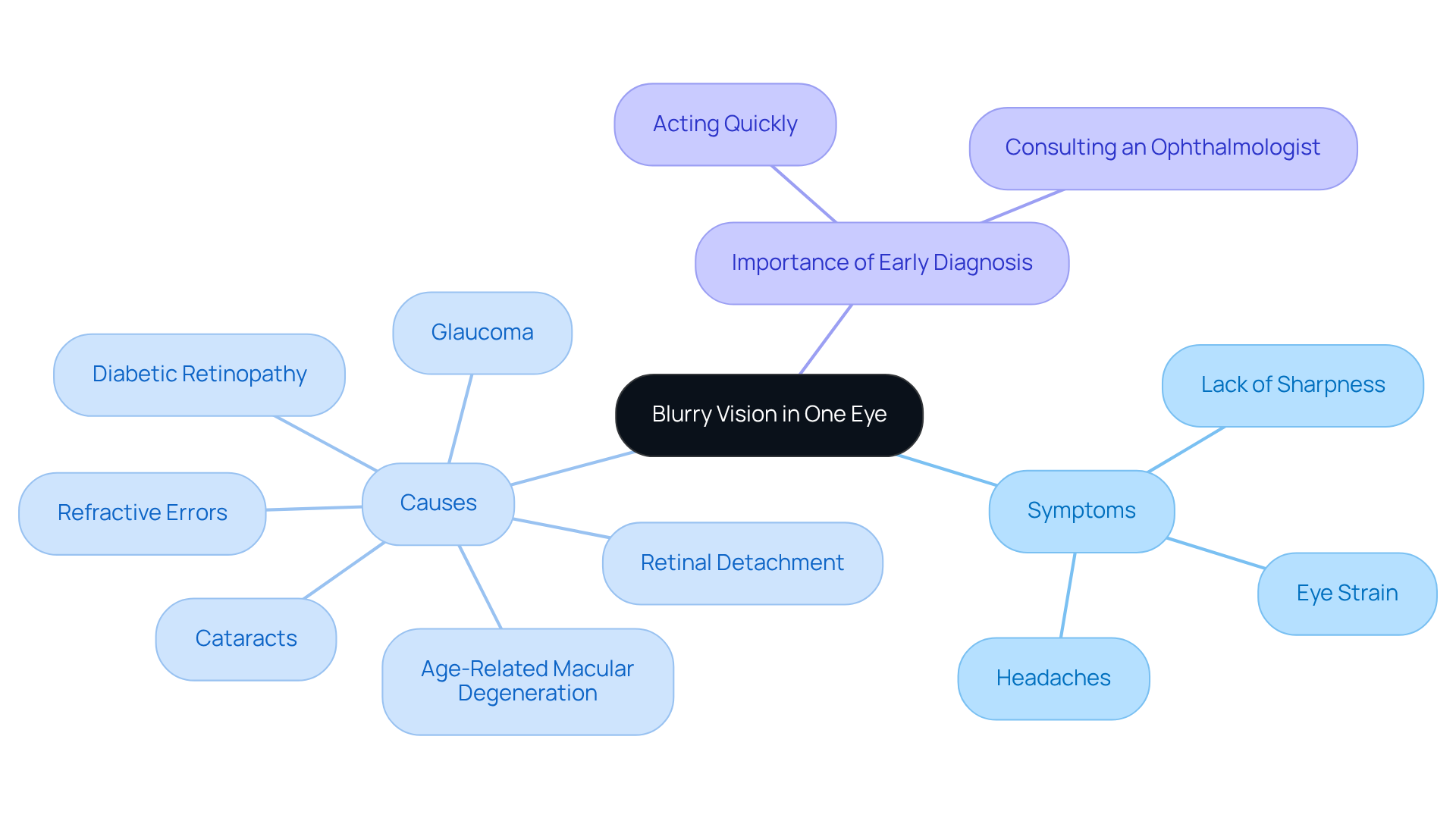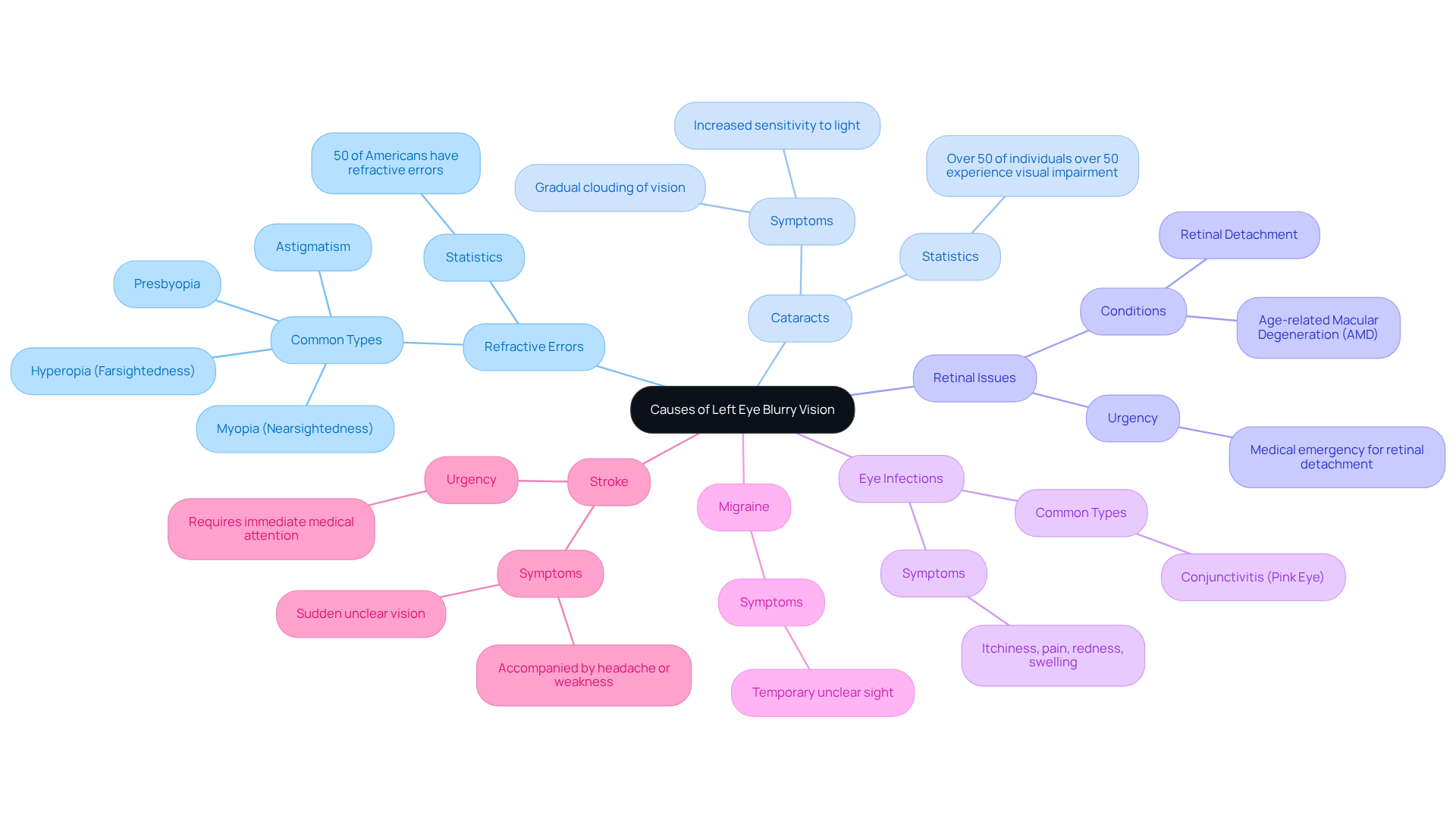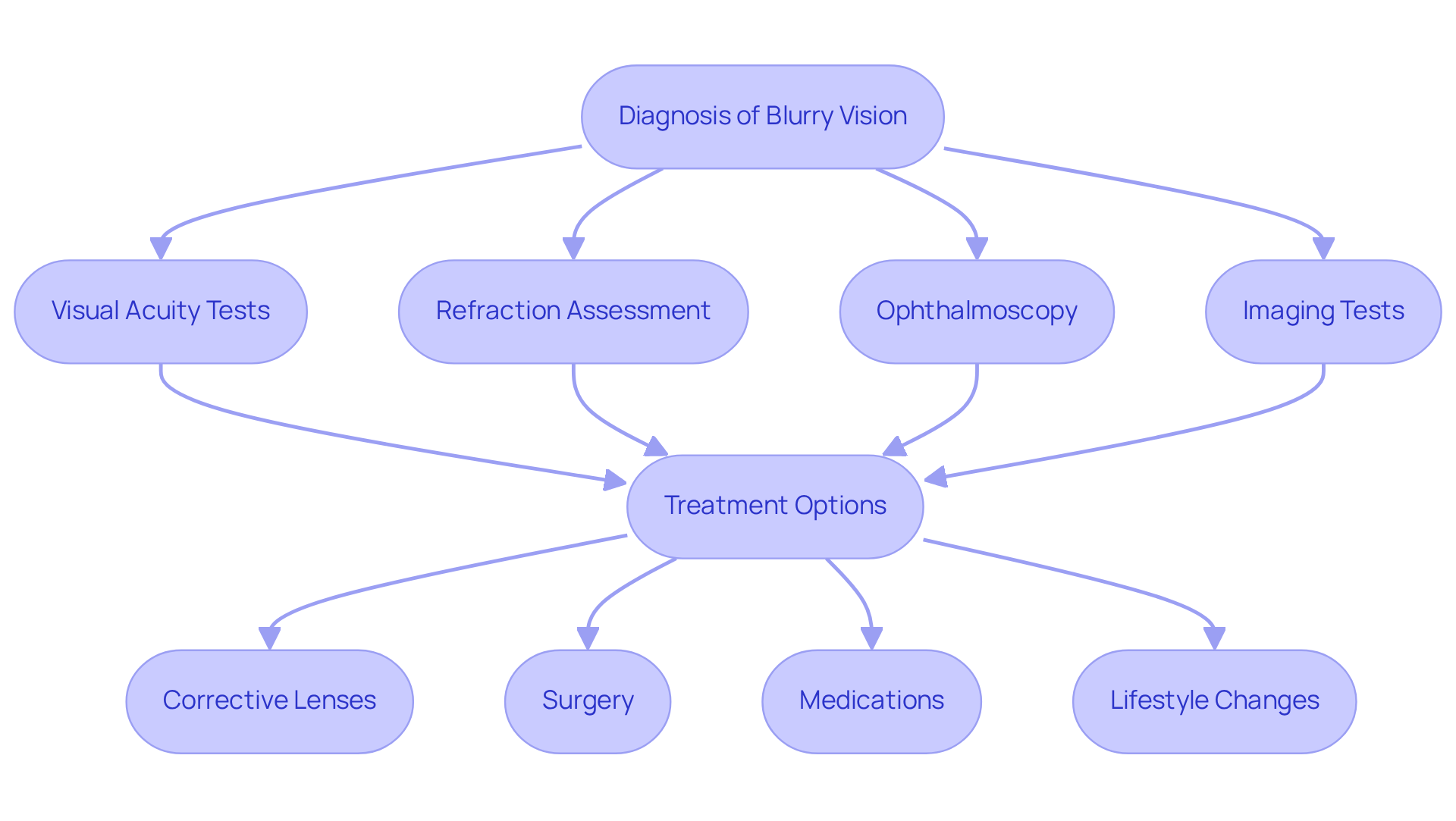Posted by: Northwest Eye in General on November 12, 2025
Introduction
Experiencing blurry vision in one eye can be unsettling, and it’s completely understandable to feel concerned. This symptom often signals a deeper issue, which can range from simple refractive errors to more serious conditions like retinal detachment. We understand that navigating these possibilities can be overwhelming, but gaining insight into the potential causes and treatment options can empower you to take proactive steps toward clearer vision.
When faced with sudden blurriness, it’s important to know that you’re not alone. Many people have experienced similar situations, and timely intervention can truly make a difference. We’re here to help you through this process, providing the support and information you need to address your eye health effectively. Remember, taking action now can lead to better outcomes and peace of mind.
Define Blurry Vision in One Eye
Experiencing blurry sight in one eye can be unsettling. It often means a lack of sharpness or clarity, making it tough to see fine details. You might feel like objects are just out of focus. This can come with other symptoms, like eye strain, discomfort, and even headaches, which can complicate your daily activities. Understanding what this means is important for you, as it helps you communicate effectively with your healthcare provider and seek the care you need.
The reasons behind unclear sight in one eye can vary widely. They range from refractive errors and cataracts to more serious conditions like retinal detachment or glaucoma. For instance, cataracts affect over 24 million Americans aged 40 and older, leading to cloudiness in the lens and blurred vision. Additionally, conditions such as diabetic retinopathy and age-related macular degeneration (AMD) are common culprits, especially among older adults. It’s common to feel concerned about these possibilities, but knowing the facts can help you feel more in control.
Ophthalmologists stress the importance of early diagnosis and intervention. As one expert wisely noted, “Blurry sight that occurs suddenly or is present only in one eye can indicate a medical emergency and should be assessed promptly by an eye specialist.” This highlights the importance of seeking immediate medical attention if you experience these symptoms. Remember, acting quickly can help prevent potential loss of sight, and we are here to support you through this process.

Explore Causes of Left Eye Blurry Vision
Experiencing left eye blurry vision can be concerning, and it’s important to understand the various factors that might be at play. Here are some common causes to consider:
- Refractive Errors: Conditions like myopia (nearsightedness) and hyperopia (farsightedness) can make one eye appear blurry, especially if your corrective prescription is outdated or incorrect. It’s worth noting that about 50% of Americans face some form of refractive error, and it can occur in just one eye, which is quite common.
- Cataracts: The gradual clouding of the eye’s lens is a frequent cause of blurred vision, often worsening over time. Studies show that over half of individuals over 50 experience some level of visual impairment due to cataracts. It’s essential to monitor your eyesight and consult an ophthalmologist for a thorough assessment.
- Retinal Issues: Conditions such as retinal detachment and age-related macular degeneration (AMD) can significantly impact your vision. Retinal detachment is a medical emergency that usually affects one eye, resulting in left eye blurry vision and can lead to rapid vision loss if not treated promptly.
- Eye Infections: Infections like conjunctivitis can cause temporary blurriness, often accompanied by symptoms like itchiness, pain, redness, and swelling. While many cases resolve on their own, persistent symptoms should prompt a visit to an eye care professional.
- Migraine: Visual disturbances linked to migraines can lead to temporary unclear sight in one eye. These symptoms typically resolve quickly, but understanding this connection can help you manage your overall eye health.
- Stroke: Sudden unclear vision, especially if accompanied by other signs like headache or weakness, can indicate a stroke, which requires immediate medical attention. Recognizing these symptoms is crucial, as sudden unclear sight in one or both eyes may signal a serious health issue.
We understand that navigating these potential causes can be overwhelming. By being aware of these factors, you can better assess your symptoms and determine the urgency of seeking professional evaluation. Remember, we are here to help you through this process and ensure you receive the appropriate care for your eye health.

Discuss Diagnosis and Treatment Options
Experiencing left eye blurry vision can be concerning, and diagnosing the cause typically involves a thorough eye examination. We understand that this process can feel overwhelming, but it’s essential for your eye health. Here are some key assessments that may be included:
- Visual Acuity Tests: These tests measure how clearly you can see with each eye, providing important information for further evaluation.
- Refraction Assessment: This helps determine the right prescription for glasses or contact lenses, which is crucial for correcting refractive errors.
- Ophthalmoscopy: This examination offers a detailed view of your retina and optic nerve, helping to identify any abnormalities that could affect your sight.
- Imaging Tests: Advanced techniques like Optical Coherence Tomography (OCT) or ultrasound may be used if retinal issues are suspected, giving a deeper insight into your eye health.
When it comes to treatment options for blurry vision, they can vary based on the underlying cause:
- Corrective Lenses: Eyeglasses or contact lenses are often prescribed to help correct refractive errors.
- Surgery: For more serious conditions, surgical options like cataract surgery or retinal repair might be necessary. The innovative Light Adjustable Lens (LAL) technology used during cataract surgery allows for personalized adjustments after the procedure, enhancing visual outcomes tailored to your lifestyle. This means your doctor can fine-tune your eyesight correction even after the lens is implanted, which is a significant advantage over conventional lenses that are permanently set.
- Medications: If there’s an infection or inflammation, medications such as antibiotics or anti-inflammatory drops can be effective in restoring your eye health.
- Lifestyle Changes: Managing screen time and staying properly hydrated can help alleviate symptoms of dry eye, which may contribute to blurry vision.
By understanding the diagnostic process and the available treatments, including advanced options like the LAL, you can engage more effectively with your healthcare provider. Remember, we are here to help you through this process, empowering you to make informed decisions about your eye health.

Conclusion
Experiencing blurry vision in one eye, especially the left, can be distressing. We understand that this condition can bring about worry and uncertainty, making it essential to recognize its various causes. These can range from refractive errors and cataracts to more serious issues like strokes. By understanding these potential underlying factors, you can communicate more effectively with your healthcare provider and take the necessary steps to protect your vision.
Key insights highlight the importance of early diagnosis and intervention. Many causes of blurry vision can lead to severe consequences if left untreated. Regular eye examinations and being aware of your symptoms are crucial for timely assessment and appropriate treatment. From corrective lenses to advanced surgical options like Light Adjustable Lens technology, there are various solutions available to effectively address blurry vision.
Ultimately, maintaining eye health is vital. Understanding the complexities of blurry vision empowers you to seek help when needed. Awareness of symptoms and proactive engagement with eye care professionals can significantly enhance your chances of preserving your vision. Taking action today can lead to a clearer tomorrow, ensuring that your eye health remains a priority. Remember, we are here to help you through this process.
Frequently Asked Questions
What does blurry vision in one eye mean?
Blurry vision in one eye indicates a lack of sharpness or clarity, making it difficult to see fine details. It may feel like objects are out of focus and can accompany symptoms like eye strain, discomfort, and headaches.
What are some common causes of blurry vision in one eye?
Common causes include refractive errors, cataracts, retinal detachment, glaucoma, diabetic retinopathy, and age-related macular degeneration (AMD).
Who is most affected by conditions that cause blurry vision?
Conditions like cataracts and AMD are particularly common among older adults, especially those aged 40 and older.
When should I seek medical attention for blurry vision in one eye?
You should seek immediate medical attention if you experience sudden blurry vision in one eye, as it can indicate a medical emergency that requires prompt assessment by an eye specialist.
Why is early diagnosis important for blurry vision?
Early diagnosis and intervention are crucial because they can help prevent potential loss of sight, allowing for timely treatment of underlying conditions.






